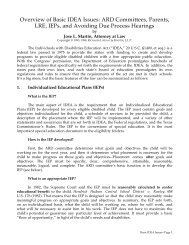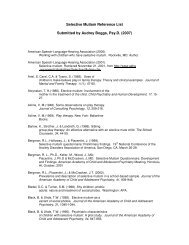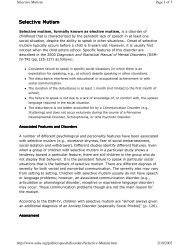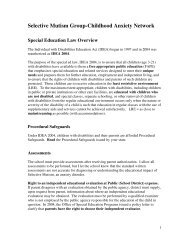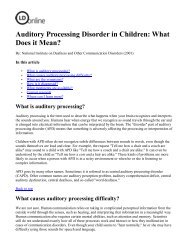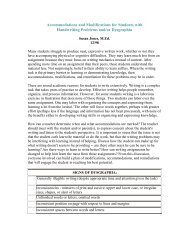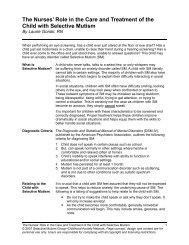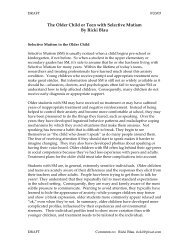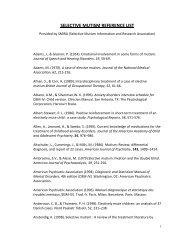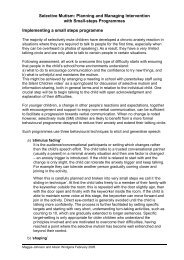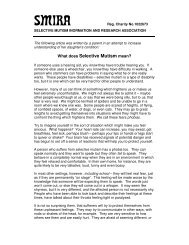Selective Mutism
to get the file - Selective Mutism Group
to get the file - Selective Mutism Group
- No tags were found...
Create successful ePaper yourself
Turn your PDF publications into a flip-book with our unique Google optimized e-Paper software.
<strong>Selective</strong> <strong>Mutism</strong>http://www.asha.org/about/publications/leader-online/archives/2002/q3/020924ftr.htmPage 1 of 79/16/2006FEATURE<strong>Selective</strong> <strong>Mutism</strong>An Integrated Treatment Approachby Robert L. Schum<strong>Selective</strong> mutism is a uniquely challenging childhood communication disorder thatdemands a coordinated treatment approach. Speech-language pathologists are inan excellent position to coordinate intervention among family, classroom teachers,and other clinicians.<strong>Selective</strong> mutism is typically a symptom of an anxiety disorder, requiringtreatment in conjunction with mental health professionals. The full impact of thedisorder is not usually manifested until the child starts school, and therefore theclassroom is frequently where the difficulties are most seriously experienced.Thus, the teacher is often the focal point of the child’s most intense symptoms.Because the child usually feels most safe and relaxed at home, practice of goodcommunication skills can be facilitated through the parents. An SLP is thecommunication expert who is present in the school, whereas the mental healthclinician is usually not in the school on a regular basis. The SLP, with knowledgeand skills in effective communication treatments, can assume leadership tocoordinate an integrated approach for the child among the school staff. Effectivetreatment of selective mutism requires a highly refined and consistent responseamong all significant adults around the child. The treatment team consists of atleast five members: the child, the parents, the teacher, the psychotherapist, andthe SLP.The Problem<strong>Selective</strong> mutism is defined as a failure to speak in specific s ocial situationsdespite speaking in other situations, and it is typically a symptom of an underlyinganxiety disorder. Children with selective mutism can speak normally in certainsettings, such as within their home or when they are alone with their parents.However, they fail to speak in other social settings, such as at school or at otherplaces outside their home. Other symptoms associated with selective mutism can
<strong>Selective</strong> <strong>Mutism</strong>http://www.asha.org/about/publications/leader-online/archives/2002/q3/020924ftr.htmPage 2 of 79/16/2006include excessive shyness, withdrawal, dependency upon parents, andoppositional behavior. Most cases of selective mutism are not the result of a singletraumatic event, but rather are the manifestation of a chronic pattern of anxiety.<strong>Mutism</strong> is not passive-aggressive behavior. Mute children report that they want tospeak in social settings, but are afraid to do so.It is important to emphasize the underlying anxiety disorder that is the likelyorigin of selective mutism. Often, one or both parents of a child with selectivemutism have a history of anxiety symptoms, including childhood shyness, socialanxiety, or panic attacks. This suggests that the child’s anxiety represents afamilial trend. For some unknown reason, the child converts the anxiety into themute symptom. The mutism is highly functional for the child in that it reducesanxiety and protects the child from the perceived challenge of social interaction.Treatment of selective mutism should focus on reduction of the general anxiety,rather than focusing only on the mute behaviors.The school setting frequently offers the greatest challenge for a child withselective mutism. This setting, with many people present and with performanceexpectations, can heighten the anxiety and therefore cause the protectivesymptom—mutism—to be exacerbated. A two-pronged approach to treatment isrecommended for children who are mute at school:individual psychotherapy to help reduce the general anxiety and to practice bettercommunication skills;a behavioral program at school to slowly shape increasingly appropriatecommunication.An effective program involves a slow, systematic program that rewards successiveapproximations of social interaction and communication. Mute children cannot betricked, cajoled, or commanded to speak. These approaches to resolving mutisminvariably fail.Any attempt at improved communication and interaction needs to be noted andreinforced, even if it is nonverbal. This includes making eye contact, followingdirections, and nonverbal participation in group activities. The successive steps inthis approach often need to be quite small. The lack of speech is only the mostobvious and dramatic sign of the underlying anxiety. Improvement of the mutismis predicated on a generalized reduction of anxiety. Therefore, reduction of otheranxiety symptoms is important and relevant to the treatment of mutism at school.Treatment Team
<strong>Selective</strong> <strong>Mutism</strong>http://www.asha.org/about/publications/leader-online/archives/2002/q3/020924ftr.htmPage 3 of 79/16/2006Parents will often notice that their preschool-aged child is shy is social situations,but they do not recognize the true extent of the mutism until the child startsschool. Sometimes the mutism will be recognized if the child starts preschool andwill not talk there. In other circumstances, the child’s problem is not identifieduntil beginning kindergarten. If a school SLP or teacher is the first professional tosuspect mutism, they should refer the parents and child to a mental healthpractitioner. A preferred referral is to a child psychologist who can work with theSLP to design a behaviorally based treatment plan, the most effective approach totreating mutism. These professionals can also consider referring the child to achild psychiatrist for a medical evaluation.Recent medical literature reports use of antidepressants to treat selective mutismin children. Although the reports are promising, they are limited in the number ofpatients treated and in the behavioral outcomes measured. In my experience, anantidepressant or an antianxiety medication is sometimes helpful in reducingassociated anxiety symptoms, but has been of limited utility in targeting mutebehaviors. At this time, parents and professionals should be cautious in theirexpectations that a medication can "cure" mutism. Rather, it is the responsibilityof the psychotherapists and the parents to determine the appropriateness ofmedication for a young child who is mute.As a psychotherapist, I establish a specific, systematic hierarchy of speakingsituations for my patient. In individual therapy, we practice each step until thechild is quite comfortable and spontaneous in that speaking situation. As the childdemonstrates comfort in the therapy room with a specific communicationbehavior, I will recommend that school staff attempt to elicit similar behaviors atschool. For example, I might start with children nodding and shaking their headsfor yes and no. Then they may proceed to mouthing, but not vocalizing, words forme. Another step may be whispering words or writing them down. In transferringthese behaviors from psychotherapy to the classroom, the SLP can help the childpractice these in individual and small group treatment, and then shadow the childto help transition the behaviors into the classroom.The SLP can also use techniques to help reduce the general anxiety of the childwith selective mutism through direct intervention and collaboration with theclassroom teacher. Routine and structure often help an anxious child. Clearlyunderstanding activities and having a predictable schedule reduce the unknown. Ifa schedule is changed or a new activity occurs, a preview of this change can behelpful. Anxious children sometimes appear to be "slow to warm up." They mightnot jump right into a new activity, but first prefer to observe other children doingan activity until they are sure that they understand what to do. Once they engagein the activity, they may require some adult assistance at first, and then have the
<strong>Selective</strong> <strong>Mutism</strong>http://www.asha.org/about/publications/leader-online/archives/2002/q3/020924ftr.htmPage 4 of 79/16/2006adult fade the assistance as the child becomes more confident in the skills. Forexample, in a kickball game, the child might want to first observe other studentsplay, later start playing with adult assistance, and then independently join in.Specific Treatment IssuesThe SLP should be alert to various behaviors that may represent anxietysymptoms. Some children may be resistant to nonverbal activities, such as groupactivities in physical education class or recess. This may represent unfamiliaritywith a new activity and anxiety about participating in something unknown. Someanxious children are resistant to making choices, unless they are quite familiarwith a situation. Even as they show improvement in speaking, they may still showthe anxiety symptoms of avoidance. If these behaviors occur, the SLP can consultwith the psychotherapist and then help the teacher implement methods to involvethe child in class activities without exacerbating the anxiety. One of my patientswas anxious about any special celebration of her birthday in the classroom, and intherapy we composed a letter to the classroom teacher requesting a modificationof the birthday activity so the child would be less anxious.In working with children who are mute, I usually use terms such as "shy" and"nervous" to describe feelings when they are reluctant to speak, and "brave" whenthey extend themselves in therapy or in the classroom. Most of my patientsunderstand these terms, and I find them helpful to use with teachers and parents.<strong>Selective</strong> mutism is often at its height during the important years of readingdevelopment. Most children with selective mutism have adequate comprehensionand reception in the classroom, but will not speak to name alphabet letters,produce phonics sounds, or read text. This presents a challenge to the teacher inassessment of the child’s reading development and suitability for promotion fromkindergarten through the primary grades. An SLP can help the teacher developdifferent methods of assessment of the child’s reading abilities. Some children areamenable to a nonverbal assessment technique, such as pointing to letters, butothers are initially reluctant to do that. Some children will allow their parents tovideotape their reading performance at home, which can then be reviewed byschool staff.An effective treatment technique is to involve the child with peers in variousactivities. Most of my patients are well accepted by their classmates, even thoughthey are mute. The classmates invite the children to their homes for play orparties and easily accept them, even though the child does not speak to them.The SLP can help identify which peers show a mutual interest in the child. The SLPcan collaborate with the teacher to set up instructional situations in which the
<strong>Selective</strong> <strong>Mutism</strong>http://www.asha.org/about/publications/leader-online/archives/2002/q3/020924ftr.htmPage 5 of 79/16/2006child is paired with a preferred peer. This peer can also be used in speech andlanguage treatment sessions with the child. Parents can be advised of thesedeveloping friendships, so that they can arrange play visits with the peer’sparents.Typically, a child with selective mutism will begin speaking to the peer in thesafety of the mute child’s home. Next, the child will speak to the peer at thepeer’s house, if the other parents are not present in the room. Then the peer isoften the first person to whom the child will speak at school. This typically occursin a somewhat isolated setting, such as a quiet area of the playground duringrecess, or when the two of them are working alone in the building, such as in thelibrary or on an assignment to the school office. The school SLP is a great resourcefor coordinating these peer events among the various members of the treatmentteam.A variation shown by slightly older children with selective mutism is to talk instructured school activities, but then be mute in other circumstances. One of mypatients answered teacher questions in class, but could not talk in unstructuredsituations, such as in the lunchroom or at recess. Rather, she gestured to herpeers or wrote them notes. Another patient tried to dominate conversations bymaintaining her chosen topic (she was an expert about a TV cartoon series). If anadult changed the topic, the child’s anxiety increased and she became mute. Inthe first case, treatment involved bringing peers into the home and then slowlyshaping speaking with peers to other settings. In the second case, therapyinvolved a shaping procedure of slowly introducing other topics to theconversation on which the patient was an "expert."Because children with selective mutism often show other anxiety symptoms,another treatment goal in the schools is to promote more spontaneity in behavior.In individual therapy, I often use various media to help the child be morespontaneous and less constricted in actions. For example, we draw with markers,cut paper, use modeling compounds, and get messy with finger paints. Theapproach is to reduce the child’s self-consciousness and inhibition. These mediaalso afford the child opportunities to communicate in a nonverbal fashion. Onepatient of mine started communicating with me by drawing pictures of recentevents at home and school. Over the next year, as she learned to read and write,she progressed from labeling the pictures to writing responses to me as weconversed in therapy. We used the creative media as a technique to move heralong the communication hierarchy in therapy.The SLP should know that the duration of mute symptoms is highly variable. Ihave had young patients show improvement in symptoms in several months, with
<strong>Selective</strong> <strong>Mutism</strong>http://www.asha.org/about/publications/leader-online/archives/2002/q3/020924ftr.htmPage 6 of 79/16/2006no more than 12 sessions of therapy. I have had other patients whose symptomshave persisted for several years. I recommend that in consulting with teachersand parents, we caution them that it may take some time until the child iscomfortable speaking spontaneously at school and in other social settings.In this context, it is important to remember that the mutism is only one specificsymptom of the social anxiety. Many times we can note improvement in other,nonverbal symptoms of anxiety. If we focus only on the mutism, we can becomediscouraged by the slow progress in the improvement of that symptom. However,if we take a broader view of the anxiety, we can often identify encouragingprogress over a wider array of behaviors. The SLP can be of great help incounseling patience with other members of the team, including parents andteachers.SummaryChildren with selective mutism need psychotherapy to address their anxietydisorder in conjunction with speech and language treatment. If the mutism is firstidentified in the school setting, the SLP should counsel the parents for a referral toa child psychotherapist who is experienced with this disorder. The SLP can thenserve as a key member of the treatment team for this child in two ways—byproviding communication treatment and by facilitating interaction among thetreatment team.The SLP can consult with the teacher on different methods of instruction andassessment of the child with selective mutism and can provide focusedcommunication treatment for the child in the school setting. The SLP can facilitategeneralization of communication skills from psychotherapy to the school setting,which is usually the most challenging situation for a child with selective mutism.The SLP has a critical role in coordinating the efforts of an entire team. Thisintegrated approach to therapy promises the best opportunity for the child’ssuccess.Additional references can be found in The ASHA Leader Online atprofessional.asha.org/news.Robert Schum is a clinical psychologist and associate professor in the Departmentof Pediatrics at the Medical College of Wisconsin. His specialty is the assessmentand treatment of children with communication disorders. Contact him by email atrschum@mcw.edu .
<strong>Selective</strong> <strong>Mutism</strong>http://www.asha.org/about/publications/leader-online/archives/2002/q3/020924ftr.htmPage 7 of 79/16/2006©1997-2006 American Speech-Language-Hearing Association -



